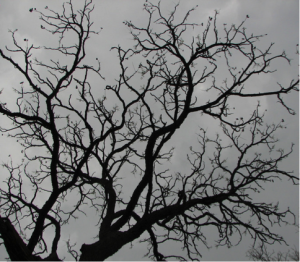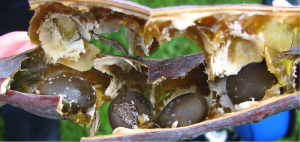My name is Sam Askenas and I am a second year student entering the McIntire School of Commerce this upcoming fall. This blog post is part of the Spring 2015 Edible Plants BioGrounds group endeavor to create a virtual map of many the edible plants located hear on grounds. My responsibility is to report on the Kentucky Coffeetree located in the Gardens at Pavilion X and Morea Gardens.
“The planting of a tree […] is a gift which you can make to posterity at almost no cost and with almost no trouble, and if the tree takes root it will far outlive the visible effect of any of your other actions, good or evil.” – George Orwell
Although predating this quote, Thomas Jefferson and the overarching University of Virginia community exudes the same sentiment in each and every way. As many of these blog posts will address, the greater Charlottesville area – and more specifically the Pavilion Gardens – have a plethora of trees and other plant life. Undoubtedly, all these trees and plants add to the beauty of our grounds, but what is more important is that this greenery can double as sustenance for people. The Kentucky Coffeetree is one such pant that adds to the character of the gardens in which it inhabits and can also be eaten as a means of nutrition.
Morea Garden: Kentucky Coffeetree. Photo from http://donnawatkins.smugmug.com/Travel/Virginia/University-of-Virginia-Homes/.
The Kentucky Coffeetree is native to North America, and was further introduced to new areas by the Native Americans. Originally, the pulp and bark were utilized as tonics and herbal remedies, but the tree was also utilized for food! A tea can easily be made from the leaves and pulp, and many Native American tribes roasted the beans for food. Additionally, Settlers would also utilize the beans as a coffee substitute. However, not the whole tree is edible. The presence of cytisine in the seeds and pods makes them poisonous to the human body if they are not roasted. It is a common belief that the cytisine in the seeds and pods is neutralized, thus rendered obsolete, in the roasting process.
Morea Garden: Seed Pod from Kentucky Coffeetree. Photo from http://donnawatkins.smugmug.com/Travel/Virginia/University-of-Virginia-Homes/.
Pavilion X is one home of the Kentucky Coffeetree here on grounds. The Kentucky Coffeetree can be seen on either side of the picturesque white bench. On top of the tree’s ability to be eaten, it offers a tremendous amount of shade and adds to the overall beauty and biodiversity of the garden. From my own experience, I can say that it was extremely peaceful to break away from the hubbub of everyday life and rest underneath this gorgeous tree.
Pavilion X Garden: Kentucky Coffeetree
The Kentucky Coffeetree can also be found in the Morea Garden. Morea was originally built in 1834 by the first professor of natural history at the University of Virginia – Dr. John Patten Emmet. Following his death in 1843, Morea has served as the residents for many UVa professors who use the grounds as a teaching tool for botany. Presently, the University of Virginia and the Albemarle Garden Club share usage and care of the garden.
Morea House. Photo from http://www.virginia.edu/webmap/popPages/185-morea.html.
Edible plants are located all around us. With the help of our virtual map, students and faculty will be able to marvel at the edible beauty that surrounds us. By making a map of these plants and trees, we hope that it will encourage more people to enjoy all the delicious wonder that they have to offer.
Post by Sam Askenas
Works Cited:
http://www.virginia.edu/uvatours/gardens/gardensOther.html
http://www.goodreads.com/quotes/tag/plants
http://donnawatkins.smugmug.com/Travel/Virginia/University-of-Virginia-Homes/i-4vHPzjz
http://www.virginia.edu/webmap/popPages/185-morea.html




